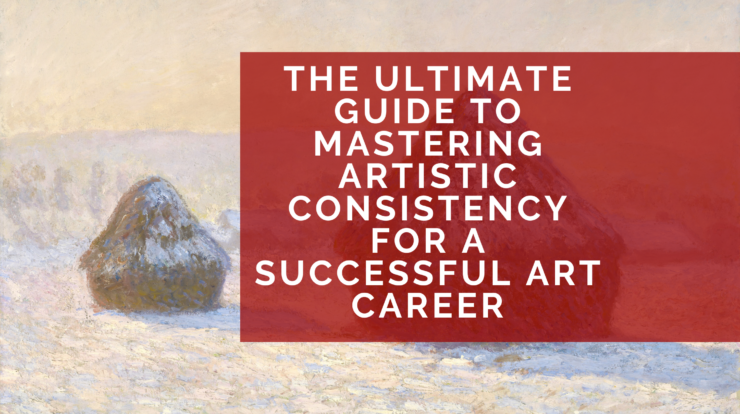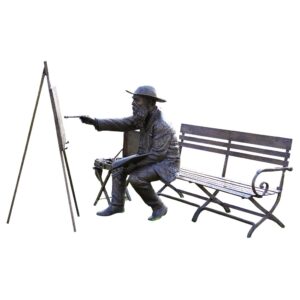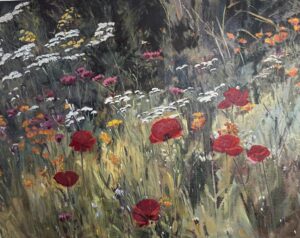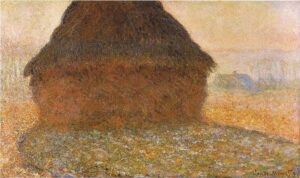
Artistic consistency is a crucial yet often overlooked aspect of an artist’s career. This consistency allows an artist to create a body of work that is easily recognizable and distinctly their own. When a collector or gallery owner views a piece, they should be able to identify it as yours without needing to see the signature. This recognizability is not just about style; it encompasses the themes, techniques, color palettes, and even the presentation of your work. By cultivating this consistency, you build your brand as an artist, establish credibility, and foster trust with your audience.
Many artists struggle with the concept of consistency, worrying that it might stifle their creativity or lead to repetitive and boring work. However, true consistency is about finding a balance between maintaining a recognizable style and allowing room for creative exploration. It’s about creating a cohesive body of work that evolves over time, reflecting your growth and mastery as an artist.
In my experience as a gallery owner, I’ve interacted with countless artists, each with their own unique approach to creating and presenting their work. Some artists have a highly consistent body of work that is immediately recognizable, while others struggle with a lack of cohesion, presenting a portfolio that feels disjointed and unfocused. Achieving artistic consistency is essential for building a sustainable career, and it is a journey that requires thoughtful consideration and deliberate practice.
Consistency demonstrates your dedication to your vision as an artist. It shows that you are committed to exploring and refining a particular style or subject matter, which is crucial for building a sustainable career. This dedication is not just about repetition for the sake of it; it’s about delving deep into your chosen themes and techniques, mastering them, and creating work that resonates on a profound level with your audience.
Moreover, consistency enhances your marketability. Galleries and collectors are more likely to invest in an artist whose work is cohesive and recognizable. This consistency helps them understand what to expect from you and builds a stronger relationship between you and your audience. When collectors see consistent, cohesive work, they can more easily understand and appreciate your artistic vision. This familiarity encourages them to invest in your work repeatedly, transforming one-time buyers into lifelong collectors.
In this article, we’ll explore the elements of artistic consistency, examine examples of artists who have successfully achieved it, and discuss practical steps you can take to build a cohesive and successful art career. We’ll also address common concerns and fears about consistency, such as the potential for boredom or stagnation, and how to balance consistency with creativity. By embracing the challenge of consistency, you’ll find that it opens up new avenues for artistic growth and long-term success.
Why Consistency Matters
Artistic consistency is more than just a stylistic choice; it is a fundamental principle that can significantly impact your success as an artist. Here are several key reasons why consistency is essential:
1. Demonstrates Dedication and Vision
Consistency shows that you are committed to your vision as an artist. It signals to collectors, galleries, and even to yourself that you are dedicated to exploring and refining a particular style or subject matter. This dedication is crucial for building a sustainable career. When your work is cohesive, it demonstrates that you believe in the direction you are pursuing and that you are invested in the long-term exploration of your chosen themes. This commitment can reassure collectors that you are a serious artist who will continue to produce work they love.
2. Builds Mastery Through Repetition
Mastery comes from repetition. Malcolm Gladwell’s concept of 10,000 hours of practice to achieve mastery applies to art as much as it does to any other field. By focusing on a consistent style or subject matter, you allow yourself to refine your techniques and develop a deeper understanding of your craft. This repetition leads to higher quality and more sophisticated pieces. As you continually explore and refine your work, you become more skilled and confident in your abilities, which in turn produces better and more compelling artwork.
3. Enhances Marketability and Recognition
Galleries and collectors are more likely to invest in an artist whose work is cohesive and recognizable. Consistency helps them understand what to expect from you and builds a stronger relationship between you and your audience. When collectors see a piece of your work, they should be able to recognize it as yours from across the room. This recognizability not only aids in building your brand but also makes it easier for galleries to market your work. A cohesive portfolio gives galleries confidence in presenting your work to potential buyers, knowing that they can rely on the consistency of your artistic vision.
4. Fosters Long-Term Collector Relationships
Consistency helps in building long-term relationships with collectors. When collectors see a cohesive body of work, it encourages them to invest not just in a single piece but in your overall artistic journey. They become interested in following your evolution and growth as an artist. By creating a consistent body of work, you make it easier for collectors to become repeat buyers, as they know they can expect new pieces that will complement their existing collection. This ongoing relationship is beneficial for both the artist and the collector, fostering a deeper connection and appreciation for your work.
5. Develops Credibility and Trust
Consistency in your work builds credibility and trust with your audience. When you consistently produce high-quality work that aligns with your artistic vision, you establish a reputation for reliability and professionalism. Collectors and galleries will trust that you can deliver on your promises, whether it’s for commissioned work or gallery exhibitions. This trust is crucial for long-term success in the art world, as it can lead to more opportunities, referrals, and a stronger presence in the market.
6. Encourages Creative Exploration Within Boundaries
Interestingly, setting boundaries through consistency can actually encourage more creative exploration. By establishing a clear framework for your work, you can delve deeper into your chosen themes and techniques, discovering new nuances and possibilities. This focused exploration can lead to innovative and exciting developments in your art, all while maintaining a cohesive and recognizable style. Consistency does not mean repetition without innovation; it means evolving and growing within a defined artistic space, which can result in a more profound and mature body of work.
It’s About Creating Recognizeable Work
In essence, artistic consistency is about creating a recognizable and cohesive body of work that reflects your dedication, enhances your skills, and builds strong relationships with your audience. It is a strategic approach that balances creativity with professionalism, leading to a more successful and sustainable art career. Embracing consistency can open new avenues for artistic growth and long-term success, making it a crucial element in the journey of every artist.
The Elements of Consistency
Achieving artistic consistency involves focusing on several key elements that collectively create a cohesive and recognizable body of work. By understanding and honing these elements, you can develop a distinctive style that sets you apart from other artists. Here are the six essential elements to consider:
1. Subject Matter
The subject matter is the core of your artwork. It encompasses the themes, stories, and emotions you convey through your pieces. Consistency in subject matter means regularly exploring similar motifs or narratives. For example, you might focus on landscapes, figurative work, or abstract concepts. This doesn’t mean you have to depict the same exact scene repeatedly, but rather that there is a common thread or theme that runs through your work. This thematic consistency helps viewers and collectors easily identify your work and connect with the recurring ideas and emotions you portray.
2. Style and Technique
Your style and technique are the distinctive ways in which you create your art. This includes your approach to composition, the types of lines and shapes you use, your brushstrokes, and the overall aesthetic of your pieces. Consistency in style and technique means developing a unique and recognizable way of working that becomes your signature. This could be the way you apply paint, the textures you create, or the compositional structures you favor. By consistently employing certain techniques, you build a recognizable style that becomes synonymous with your name.
3. Palette
The palette refers to the colors and tones you use in your work. A consistent color palette can significantly enhance the cohesiveness of your art. Whether you prefer vibrant, bold colors, muted tones, or monochromatic schemes, sticking to a consistent palette helps tie your work together visually. It creates a sense of harmony and unity across different pieces, making it easier for viewers to recognize your work. Over time, collectors will come to associate specific color combinations with your artistic vision, further strengthening your brand.
4. Medium
The medium you choose to work with is another crucial element of consistency. Whether you work with oils, acrylics, watercolor, sculpture, or mixed media, maintaining consistency in your chosen medium helps build a cohesive body of work. This doesn’t mean you can’t experiment with different materials, but having a primary medium that defines your work can provide a stable foundation. Consistent use of a particular medium allows you to develop expertise and a deeper understanding of its possibilities, leading to more refined and sophisticated pieces.
5. Presentation
Presentation involves how you frame, mat, or display your work. Consistent presentation adds a professional touch to your portfolio and reinforces the cohesiveness of your body of work. For two-dimensional art, this could mean using similar frames or mats, while for three-dimensional art, it could involve consistent bases or display methods. Presentation consistency ensures that your work is easily recognizable and visually unified when displayed together. It also enhances the overall aesthetic appeal, making your work more attractive to collectors and galleries.
6. Thematic Elements
Thematic elements are the underlying narratives or messages in your work. They reflect the deeper meanings, philosophies, or emotions you wish to convey. Consistency in thematic elements means exploring similar ideas or concepts across your pieces. This could be a recurring exploration of nature, human experiences, societal issues, or abstract ideas. By consistently integrating certain themes into your work, you create a body of art that resonates on a deeper level with your audience. These thematic threads help viewers connect emotionally and intellectually with your work, fostering a stronger appreciation and understanding.
Balancing Consistency with Creativity
While achieving consistency is essential, it’s important to balance it with creativity to avoid monotony. Here are some strategies to maintain this balance:
- Incremental Changes: Introduce small variations within your consistent framework. This allows you to explore new ideas without deviating too far from your established style.
- Sub-Series: Create sub-series within your broader body of work. Each sub-series can explore different aspects of your chosen theme or style, providing variety while maintaining overall cohesion.
- Personal Projects: Experiment with new techniques or themes in personal projects that may not be immediately shown to the public. These projects can rejuvenate your creativity and may eventually influence your main body of work.
By focusing on these six elements and finding the right balance between consistency and creativity, you can develop a distinctive and cohesive body of work that stands out in the art world. This approach not only enhances your artistic identity but also builds stronger connections with collectors and galleries, paving the way for a successful and sustainable art career.
Examples of Consistency in Action
Achieving artistic consistency can significantly impact an artist’s success and recognizability. Let’s explore some examples of artists, some of whom we represent at Xanadu Gallery, and another you’ll have no problem recognizing, who have mastered the art of consistency, examining how they maintain cohesion across their body of work while still allowing room for creativity and exploration.
Elisabeth Ladwig
Elisabeth Ladwig is a fine art photographer and digital artist whose work we have represented for several years. Her pieces are immediately recognizable due to their cohesive style, subject matter, and presentation. Elisabeth’s work often features a narrative quality, with each piece telling a story that resonates with viewers. Her consistent use of certain thematic elements, such as dreamlike figures and ethereal landscapes, ties her body of work together. Additionally, her choice of framing and presentation adds another layer of cohesion, ensuring that her pieces, when displayed together, create a harmonious visual experience.

by Elisabeth Ladwig
18″ x 12″ | Photo Collage on Watercolor Paper

by Elisabeth Ladwig
24″ x 16″ | Photo Collage on Watercolor Paper

by Elisabeth Ladwig
18″ x 12″ | Photo Collage on Watercolor Paper
Dave Newman
Dave Newman is a mixed media artist known for his large-scale collage works. He has been a staple at Xanadu Gallery for over 15 years. Dave’s work showcases a bold color palette and Americana themes, creating a sense of nostalgia and connection to American culture. Despite the variety in his compositions, the thematic elements, such as vintage signs, maps, and iconic imagery, provide a consistent thread throughout his work. Dave also maintains cohesion through his presentation methods, using similar framing techniques for his wall pieces and incorporating consistent elements in his freestanding sculptures. This blend of consistency and variety ensures that his work remains fresh and engaging while still being instantly recognizable.

by Dave Newman
20″ x 10″ | Acrylic /Mixed Media

by Dave Newman
24″ x 30″ | Acrylic /Mixed Media

by Dave Newman
18″ x 18″ | Acrylic /Mixed Media
Gary Price
Gary Price, a sculptor who has been with Xanadu Gallery for many years, exemplifies consistency through his subject matter, style, and presentation. His bronze sculptures, often depicting human figures, are known for their intricate details and expressive forms. Gary’s consistent use of bronze as a medium, along with his distinctive patinas, helps to create a unified body of work. Whether it’s a small tabletop piece or a large-scale public installation, Gary’s sculptures are immediately identifiable. His focus on the human form and his mastery of the medium allow him to create pieces that are both cohesive and captivating.

by Gary Lee Price
48″ x 52″ | Bronze

by Gary Lee Price
53″ x 60″ | Bronze

by Gary Lee Price
75″ x 35″ | Bronze
John Horejs
John Horejs, a lifelong painter (and my father!), provides an excellent example of how consistency and variety can coexist. John’s work spans a wide range of subjects, from ocean scenes and mountain landscapes to desert vistas and wildflower gardens. Despite this variety, his work remains cohesive due to several consistent elements. John’s distinctive brushstrokes, limited color palette (consisting of seven colors and white), and his unique presentation method (box-stretched canvases with a white border) all contribute to the recognizability of his work. Collectors can see the underlying consistency in his technique and style, even as he explores diverse subject matter.

by John Horejs
40″ x 60″ | Oil

by John Horejs
30″ x 60″ | Oil

by John Horejs
40″ x 50″ | Oil
Claude Monet
Claude Monet’s work, particularly his series such as the Haystacks and Water Lilies, illustrates how an artist can achieve deep exploration within a consistent framework. Monet’s repeated exploration of the same subjects under different lighting and atmospheric conditions allowed him to delve into subtle variations of color, light, and shadow. This method not only created a cohesive series but also demonstrated Monet’s mastery and deep understanding of his subjects. His work shows that consistency does not mean stagnation; rather, it can lead to profound insights and innovative developments in an artist’s oeuvre.

Year 1890–91
Medium Oil on canvas
Dimensions 23+5⁄8 in × 39+3⁄8 in

Consistency Needn’t Mean a Sacrifice of Creativity
The artists highlighted here demonstrate that achieving consistency does not mean sacrificing creativity. By focusing on specific elements such as subject matter, style, palette, medium, and presentation, they create a cohesive body of work that remains engaging and dynamic. This balance allows for creative exploration within a recognizable framework, making their work both distinctive and marketable.
These examples show how consistency can be a powerful tool for artists. By establishing a cohesive and recognizable body of work, you build a strong artistic identity that resonates with collectors and galleries. This consistency fosters long-term relationships, enhances marketability, and paves the way for sustained success in the art world.
Practical Steps to Achieve Consistency
Achieving artistic consistency is a deliberate and thoughtful process. It involves understanding your artistic vision, refining your techniques, and making strategic choices that help create a cohesive body of work. Here are some practical steps you can take to build consistency in your art:
1. Self-Evaluation and Reflection
Begin by evaluating your current body of work. Take a critical look at your portfolio and identify the elements that are already consistent and those that need more focus. Ask yourself questions like:
- What themes or subjects do I frequently explore?
- What techniques and styles do I consistently use?
- What color palettes dominate my work?
- How do I typically present my pieces?
This self-evaluation will help you understand where you currently stand and what areas require more attention to achieve a cohesive and recognizable style.
2. Create a Consistency Checklist
Develop a checklist that outlines the key elements of consistency: subject matter, style and technique, palette, medium, presentation, and thematic elements. Use this checklist as a guide whenever you create new work. Ensure that your new pieces align with the majority of these elements to maintain a cohesive body of work.
3. Focus on a Signature Style
Identify and develop your signature style. This is the unique way you create and present your art that makes it distinctly yours. Your signature style could be the way you apply paint, the textures you create, the compositions you prefer, or the color schemes you use. By focusing on these unique aspects, you create a recognizable brand that sets you apart from other artists.
4. Experiment Within a Framework
While consistency is key, it’s also important to allow room for creativity and experimentation. Set a framework that defines the consistent elements of your work, such as palette and presentation, and then experiment within those boundaries. This approach allows you to explore new ideas and techniques without straying too far from your established style.
5. Develop a Series
Creating a series of artworks can help reinforce consistency. A series allows you to explore a particular theme, subject, or technique in depth, creating a cohesive collection of pieces. Aim to create four to six works that emphasize consistency. This exercise will help you understand how different pieces can relate to each other and strengthen the overall cohesion of your portfolio.
6. Maintain Consistent Presentation
Presentation plays a significant role in achieving consistency. Ensure that your framing, matting, or display methods are uniform across your body of work. Consistent presentation not only enhances the visual appeal of your portfolio but also reinforces the cohesiveness of your work when displayed together.
7. Document Your Process
Keep a detailed record of your artistic process. Documenting the steps you take to create your work, including the materials you use, the techniques you employ, and the thematic choices you make, can help you maintain consistency. This documentation serves as a reference point, ensuring that future works align with your established style and vision.
8. Seek Feedback
Share your work with trusted peers, mentors, or gallery owners and seek their feedback on the consistency of your portfolio. Constructive feedback can provide valuable insights into how cohesive your work appears to others and highlight areas for improvement.
9. Revisit and Revise
Consistency is an ongoing process that requires regular reflection and adjustment. Periodically revisit your portfolio and evaluate whether new pieces align with your established style and themes. Don’t be afraid to revise or rework pieces that don’t fit cohesively with the rest of your body of work.
10. Set Goals and Monitor Progress
Set specific goals for achieving consistency in your work. These goals could include focusing on a particular theme, mastering a specific technique, or creating a series of related pieces. Monitor your progress towards these goals and adjust your approach as needed to ensure that you are continually working towards a cohesive and recognizable body of work.
Achieving Consistency is a Journey
By following these practical steps, you can develop a consistent and cohesive body of work that stands out in the art world. Consistency not only enhances your artistic identity but also builds stronger connections with collectors and galleries, paving the way for a successful and sustainable art career. Remember, achieving consistency is a journey that evolves over time, reflecting your growth and mastery as an artist. Embrace the process, and watch how it transforms your artistic practice and career.

All of this sounds reasonable in theory, but I live near a major art center and I see a lot of the work that galleries have and promote. What I’m seeing all too often is FORMULA art rather then the kind of balancing of consistency with creativity you write about. I lay that on the galleries more than the artists, having had my work in that market and knowing what I was pressured to generate. I finally decided that if I had to do one more painting that the curator was always encouraging me to do I was going to HURL, and it’s one of the reasons I left that gallery after a number of years. But it’s not just the bad experience I had. I see work in those galleries that are basically a weak reshuffling of the same elements, the same style, the same palette, the same subjects. And that work is glorified by all kinds of hyperbole! Galleries really need to find a way to follow the creative lead of artists where it goes, and to communicate that organic journey to collectors.
The gallerys I have delt with seem to want only what their current and past customers will buy rather than promoting something new and different and trying to entice a new market in their gallery.
I as an artist want to try new things and ideas rather than do one type of painting over and over.
I do get the fact that sales are all good for the gallery and the artist but sometimes doing something fresh and exciting can up the interest and create some excitement in the marketing as well as add to the interest for new customers for the gallery and artist.
I understand the frustration of feeling pressured to stick to what sells rather than exploring new ideas. It’s a challenging balance for galleries to both meet the demands of their current clientele and introduce fresh, exciting work.
As a gallery owner, I recognize the importance of sales for both the gallery and the artist. However, promoting new and different work can invigorate the market and attract new customers. It’s about finding that balance between consistency and innovation to keep both the artist and the audience engaged.
Your perspective highlights the need for galleries to support artistic exploration while also considering market demands. This balance can create a dynamic environment that benefits everyone involved.
Thank you for sharing your experience and perspective. I understand your frustration with the pressures of producing formulaic art, and your concern is a valid one. The balance between consistency and creativity is indeed delicate, and it’s unfortunate that many galleries prioritize a commercial formula over artistic innovation.
As a gallery owner, I recognize that galleries must find what sells to stay in business. It’s a balancing act between supporting artists’ creative journeys and meeting market demands. Consistency should serve as a foundation, allowing for exploration and growth, rather than constraining the artist’s vision.
Galleries play a crucial role in this dynamic, and it’s essential for them to support and communicate the organic journey of an artist’s work to collectors. It’s a journey that should evolve naturally, reflecting both the artist’s growth and the consistent elements that make their work recognizable.
Thank you again for your comment. It’s a reminder that we, as gallery owners, need to continually strive to support artists in a way that honors their creativity while also helping them build a cohesive and recognizable body of work.
This is a wonderful, in depth, re-write on this subject. I appreciate the clarity of your explanations and the new examples you have illustrated this article with. Thank you.
Thanks Sherrie!
Nice write up, but consistency, means what the gallery can sell in their opinion, you learn a certain trick and stick with it because it sells, good for the gallery but a quick road to Boredom for the artist. Paint what interests you then if someone likes it then they will buy it. Consistency adds up to being a Mc Donalds, you just change a few things but basically keep painting the same thing just tweak it now and then.
Consistency doesn’t mean sacrificing creativity or becoming formulaic like a fast-food chain. It’s about building a recognizable style and a cohesive body of work, which helps in creating a strong artistic identity. This doesn’t prevent artists from exploring new ideas. Instead, it provides a foundation that can evolve over time. Successful galleries find a balance, supporting artists in their creative journey while also understanding what appeals to their collectors. This approach ensures long-term growth and engagement for both the artist and the gallery.
Thank you so much. Did you write a similar article about 3 years ago?
Hi Jason,
Nice write up on an interesting and important subject. I have two questions. First, concerning the issue of an artist’s ability to be creative while remaining consistent – – How would you feel about an artist supplying work with one voice to Gallery A while supplying work with a different voice to Gallery B, maybe while using a pseudonym? Second, you indicate that it could be useful for an artist to find a mentor or a critical reviewer to provide advice on finding one’s voice. How does one find such a person?
Thank you for your thoughtful questions.
Regarding your first question, having an artist supply work with one voice to Gallery A and a different voice to Gallery B can work, but it’s challenging. It’s hard enough to establish yourself as one successful artist, let alone managing two separate artistic identities. I recommend focusing on achieving success with your first body of work before considering the exposure of a second body under a different voice or pseudonym.
As for finding a mentor or critical reviewer, networking is key. Attend art fairs, exhibitions, and industry events to connect with experienced artists and professionals. Join art associations or online communities where mentorship opportunities may arise. Don’t hesitate to reach out directly to artists or reviewers whose work and opinions you respect, as many are willing to offer guidance.
Helpful and thorough article Jason. All good reminders. A few decades ago, I was known for watercolor still life and portraiture; while I was good at those subjects, I’ve been emotionally attracted to landscape for most of my life. About 15 years ago, I transitioned to traditional landscapes in oil and acrylic, and I never looked back. Your checklists still apply to my current position, and I’m reassured by your article as I’m still working at developing a consistent style.
I have to say that looking at other artists on social media is not helpful because I think, “Yeah, I could do that – I bet it would sell”. Then I lose my own vision after awhile, which for me, needs much self-discovery and thoughtfulness in solitude.